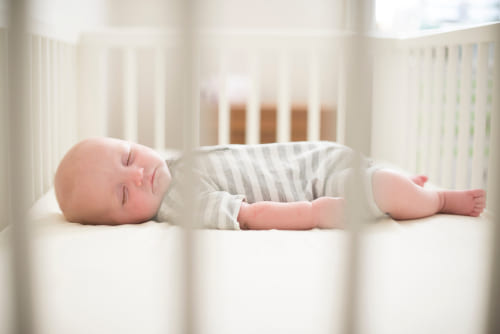If you have a child that is frequently vomiting when upset (during sleep training or otherwise), this blog is for you. First, I’ll say that it can be a tricky balance when sleep training. You’re trying so hard to allow your child the time he/she needs to sharpen the skill of self-soothing, but you certainly don’t want that practice time to result in vomiting.
On top of that, when your child is upset, you obviously want to soothe them to not only calm and comfort them, but also to AVOID THE VOMIT, STOP THE PUKE, BANISH THE BARF! Once baby vomits, it’s sad and dreadful for both of you, but it also means a round of cleanup and another attempt at resettling your child for sleep…both of which take time and patience. By this point of the night, you might feel like both of those things are running rather thin.
First, I want to talk about why a child vomits when they are crying. After that, we’ll get into some cleanup and calming tips. Sometimes vomiting is developmental, sometimes it’s done as a behavior – let me explain.
Why do Babies & Children Vomit When Upset?
- Babies vomit if they’ve been crying or upset for an extended period of time.
- Babies vomit immediately at the first sign of a tear because of an underdeveloped esophageal sphincter – the flap that randomly opens and closes, but takes time to mature as babies grow.
- Over-feeding and the same underdevelopment can cause spit-up or vomit, though projectile vomit is a sign of a possible issue, like GERD and you should speak to your Pediatrician.
- Others, believe it or not, can vomit at will…because they may already understand that it means you will come back to them, clean them up, and best of all….snuggle with them until they are asleep.
As you’ve gotten to know your baby, you’ve likely learned by now that his/her main form of communication is crying. When a baby cries longer or more intensely than they do normally, their bodies are producing more mucous, tears, and congestion while crying – this can lead to gagging and/or vomiting. Sure, there are other reasons why babies will vomit (overfed, upset tummy, food/milk disagreement, etc), but we’re specifically talking about the vomiting that occurs when babies become upset during sleep training or another prolonged crying, like waking from a nap and waiting to get scooped up.
How do you navigate the world of vomiting during sleep training with the tips shown below:
ISSUE: BABY IS KNOWN TO PUKE WHEN UPSET DURING SLEEP TRAINING.
TIP #1: KEEP BABY CALM ENOUGH NOT TO VOMIT, WITHOUT YOU PUTTING THEM TO SLEEP.
Soothing tips for Baby (before or after the puke):
- White noise can have a calming effect on babies. Without going overboard, turn the white noise machine on or up just a little bit while you’re trying to calm him/her. Some experts believe that this white noise is similar to what babies heard while they were in their mother’s womb and has a calming effect on them. Bonus – it will help drown out any other ambient noises around the house or outside baby’s windows so that once they fall asleep, they are less likely to wake up by something else.
- If a baby is getting upset to the point that you’re worried he/she will puke, try some voice and/or touch calming measures. You can go over to the crib or bassinet and use your voice by either “shhhhhh”ing, humming, quietly singing, or whispering things like “Mommy is here, you are safe, it’s OK to sleep.” If the baby calms with just your voice, fantastic!
TIP #2: KEEP YOURSELF CALM WHILE TRYING TO CALM THE BABY. CALM BREEDS CALM.
Patience & Calming tips for caregivers:
- Take a few deep, calming breaths and focus on your breathing for just a few moments.
- Trade off with your partner. Have them step in to take over for just a few minutes, or until a baby is asleep. A fresh set of patience and a calm demeanor will also help soothe the baby. While your partner is cleaning up the baby, you can strip the bed down to the second fresh crib sheet (since you “double bagged” as suggested above). Easy Peasy.
TIP #3: MAKE YOUR CLEANUP PROCESS AS QUICK AND EASY AS POSSIBLE
Clean-up tips:
- “Double Bag” the crib mattress.
- Have a change of clothes/pajamas/sleepsuit at the ready before bed each night.
Why Back is Best for an Infant Sleeping & Vomiting?
The first year of life, here at Tiny Transitions we speak to back is best, and vomiting is just one of the reasons. According to the NIH, “When on their back, baby’s trachea or windpipe (tube to the lungs) lies on top of the esophagus (tube to the stomach). Anything regurgitated, refluxed, or spit up from the stomach through the esophagus has to go against gravity to get to the windpipe and cause choking. When on the stomach, such fluids leave baby’s esophagus and pool at the opening for the windpipe, making choking more likely.” While we want to avoid vomiting from upset, babies will naturally spit up sometimes, and so even if not sleep training, it’s important that children sleep on their back, in a hard flat sleep space.
Long story short here, you need to find what works for your child to keep them calm enough to avoid the vomit, but without putting them to sleep. It can be done!
Some babies vomit if they’ve been crying or upset for an extended period of time. Some babies vomit at the drop of a hat when mom or dad leaves the room at night. Others, believe it or not, can vomit at will…because they may already understand that it means you will come back to them, clean them up, and best of all…snuggle with them.


